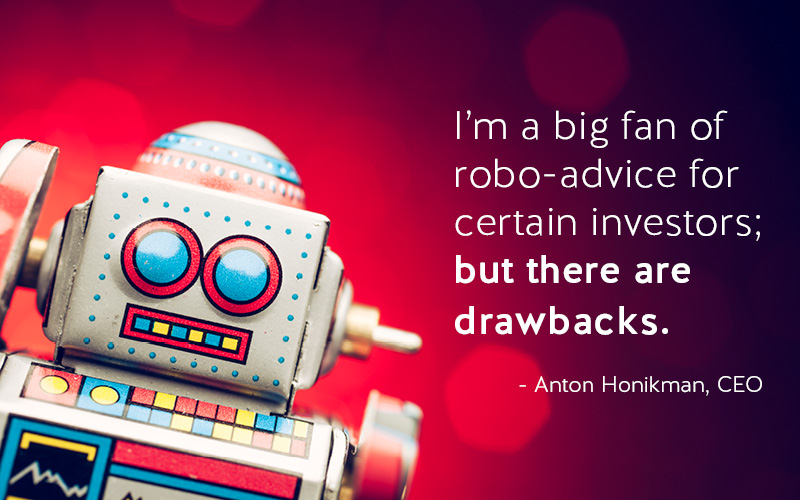It’s great for simple investing, but it can’t handle complex situations.
Originally published in U.S. News & World Report | November 10, 2016 | By Debbie Carlson
Robo-advising is beginning to make further inroads with savers and investors.
Robo-advising, sometimes called automatic investment, has been around since 2010, with the launch of firms like Betterment. Users of these wealth-management platforms input their goals and investment tolerance, then the system uses an algorithm to set up a portfolio for the client, all without human interaction.
These systems became a way for people able to invest at a low cost in basic portfolios since they likely didn’t have enough assets to receive investment advice from traditional financial planner. And these platforms have grown in popularity. Consulting firm A.T. Kearney forecast by 2020 that assets under management by robo-advisors are estimated to increase 68 percent annually to about $2.2 trillion.
People who are considering using these systems should look at their investing needs. Financial planners say these platforms offer a lot of benefits for investors, especially for people just starting out or with simple investing goals. Where the platforms fall short is when investors need to have some sort of human interaction to discuss more complex financial circumstances, such as taxes or estate planning.
Deep investing knowledge, pockets not required. Dave McConnell, director of investments with The Private Client Group of U.S. Bank in Minneapolis, says since many financial planners set minimum asset thresholds before they’ll work with a client, most small investors were priced out.
With robo-advisors, people can open an account with nearly zero assets and play zero fees in some cases, although there is some cost baked into the portfolio’s actual investments. It also doesn’t require the person to have to do a lot of research for something they don’t understand, McConnell says.
“They don’t have to learn a lot about investing to end up with a sound investment portfolio,” he says, since the person puts in their goals and risk tolerance and the algorithm picks the investments.
McConnell says the algorithms use modern portfolio theory, which builds portfolios to get an optimal return based on a given level of market risk.
Anton Honikman, chief executive officer of San Francisco-based wealth-management technology firm MyVest, says even for people with some assets who were either picking investments themselves or paying a broker to trade, robo-advisors are “dramatic improvement.”
“These are people (usually) with $150,000 or less of accumulated investable savings. They’re either making bad decisions if left to their own devices or getting ripped off by brokers,” he says. “The robo-advisors are not a rip-off. They’re generally low fee, they’re generally highly diversified, they’re a risk-managed, easy-to-access solution. I’m a big fan of robo-advisors for that audience.”
Enthusiasm for robo-advisors is up. Interest in robo-advising is rising even with people who can afford traditional planners. A survey by IMS Wealth Management Monitor showed 63 percent of respondents said that they were aware of the term robo-advisor, with the more affluent the person the more likely they were to know about it.
McConnell says the low cost of the robo-advisor is attractive even to people who can afford financial planners. Platforms will charge some fees when portfolio balances reach certain thresholds, but most don’t exceed 90 basis points, which is less than what many financial planners charge.
And as the platforms get more sophisticated, some are beginning to offer advice. Betterment, for instances, offers financial consultations for people with $250,000 or more, which begins to encroach on the financial planner’s turf. And with the systems available 24/7, investors can log in day or night and look at their portfolios.
You get what you pay for. While there are a lot of benefits to the robo-advisors, with cost and simplicity being the big benefits, there are also downsides.
Phil Cunningham, chief executive officer of Milwaukee-based financial technology firm Advicent, says the lack of human interaction may mean investors may forget about certain important factors that could influence their goals.
“The robo-advisor doesn’t know if I’ve keyed in all my assets,” he says. “It doesn’t understand the behavioral aspects of my life. It’s just data points and running an algorithm.”
McConnell agrees that robo-advisors miss on the emotional side of investing, which is what a human financial advisor brings, particularly when financial markets are volatile.
“The advisor can keep you on track with your long-term strategy; that is the biggest value they have,” he says. “If you’re on your own, oftentimes you’re not getting the advice (on long-term strategy). Like in 2008 many people pulled out of the market. That kind of reaction hurt a lot of people. Some had to go back to work and postpone retirement a decade because of bad decisions they made.”
As the technology currently stands, there’s no integration with other parts of the person’s financial life, Honikman says.
“The drawback is (the platform) not integrated with (the person’s) lending, their (salary), their pensions, their defined contribution plans,” he says. “It’s not really holistically looking at their entire financial life.”
Because the platforms use algorithms to plan portfolios, there’s not much deviation allowed from the plan. “You might not want modern portfolio theory. You also can’t buy a stock here or there,” McConnell says.
These are also not for people who have more complex financial lives, McConnell, Cunningham and Honikman say.
“These platforms are not tailored to handle those more complex needs. Those complex needs range from accommodating tax circumstances, multi-generational estate planning, philanthropy, tax management to how to handle accounts outside of the robo offering,” Honikman says. “Those are more sophisticated needs which are prevalent at a higher (asset) level and the robo doesn’t accommodate that.”

![MyVest CEO predicts growth in model-delivery direct indexing [FundFire]](https://www.myvest.com/wp-content/uploads/Fundfire-1.png)
![MyVest CEO talks UMA upgrades and industry trends [FundFire]](https://www.myvest.com/wp-content/uploads/Fundfire.png)

![How to unlock tax savings in incoming client portfolios [Financial Planning]](https://www.myvest.com/wp-content/uploads/Anton-FP-.png)
![The Holistic Impact of Wealth and Retirement Plan Advisory M&A [PlanAdvisor]](https://www.myvest.com/wp-content/uploads/Screenshot-2024-08-13-at-9.50.52 AM.png)